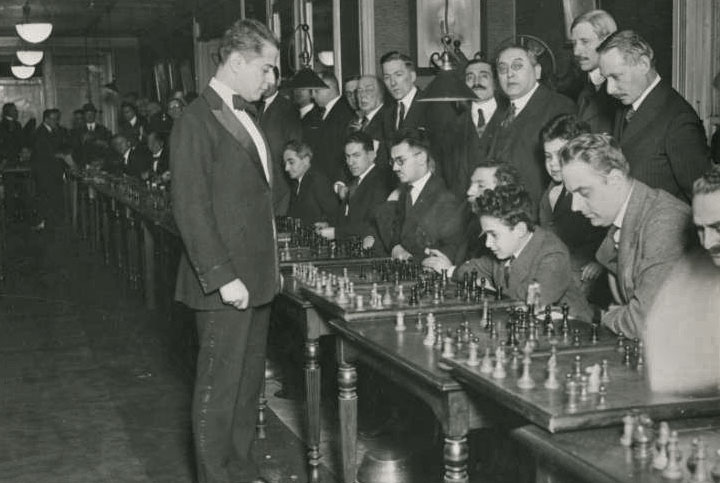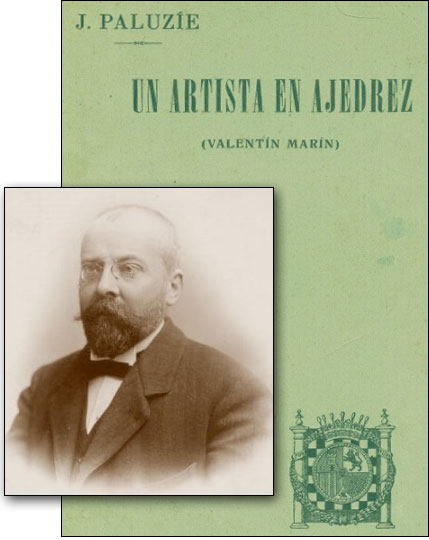Meeting a master composer
Barcelona, the 20th of February, 1920. Chess aficionados are eagerly waiting for the arrival of Jose Raul Capablanca. The Cuban genius is at the height of his powers, winning tournament after tournament (not before long he wins the world championship title from Dr. Emanuel Lasker).
He is here in Barcelona for a simultaneous exhibition. When he walks into the hall there is a thunderous applause. After a formal welcome the simultaneous exhibition is on.
 The name Emanuel Lasker will always be linked with his incredible 27 years reign on the throne of world chess. In 1894, at the age of 25, he had already won the world title from Wilhelm Steinitz and his record number of years on the throne did not end till 1921 when Lasker had to accept the superiority of Jose Raul Capablanca. But not only had the only German world champion so far seen off all challengers for many years, he had also won the greatest tournaments of his age, sometimes with an enormous lead. The fascinating question is, how did he manage that?
The name Emanuel Lasker will always be linked with his incredible 27 years reign on the throne of world chess. In 1894, at the age of 25, he had already won the world title from Wilhelm Steinitz and his record number of years on the throne did not end till 1921 when Lasker had to accept the superiority of Jose Raul Capablanca. But not only had the only German world champion so far seen off all challengers for many years, he had also won the greatest tournaments of his age, sometimes with an enormous lead. The fascinating question is, how did he manage that?
Photo: Cleveland Public Library
Capa moves with confident, rapid strides. Soon lightning strikes board after board, most opponents giving up the ghost. Capa signs a couple of peace treaties and here and returns to one board where he should be winning. However, a surprise awaits him.

[Event "Simultaneous Display "] [Site "?"] [Date "1920.02.20"] [Round "?"] [White "Capablanca, Jose Raul"] [Black "Marin y Llovet, Valentin"] [Result "0-1"] [ECO "D07"] [Annotator "Nagesh Havanur"] [PlyCount "58"] [EventDate "1920.??.??"] 1. d4 d5 2. c4 Nc6 {The Chigorin Defence, a rare system that leads to complex, unbalanced positions.} 3. Nf3 Bg4 4. e3 {A passive continuation. Valery Bronznik writes, "White protects both c4 and d4 pawns, but locks up his queen's bishop and does not exert any pressure on Black's centre."} ({The modern preference is for} 4. cxd5 Bxf3 5. gxf3 Qxd5 6. e3 e6 {with a complex game.}) 4... e6 {This is not bad.} ({However,} 4... e5 {is sharper.}) 5. Qb3 Bb4+ 6. Nc3 Bxf3 7. gxf3 Nge7 8. Bd2 O-O 9. O-O-O {Capa goes for a hand to hand combat with kings castled on opposite sides.} (9. Bd3 dxc4 10. Bxc4 Qd6 { is OK for Black.}) 9... Rb8 10. h4 dxc4 11. Bxc4 b5 12. Bd3 Bxc3 13. Bxc3 Nd5 $2 {It's hard to believe that this obvious move can be a mistake. Unfortunately, it weakens the position of the knight on c6 and soon one of the White rooks occupies the c-file.} (13... Qd6 {followed by...a5 would have given Black sufficient counterplay.}) 14. Bd2 {Capa wants to preserve his bishops.} Rb6 15. Kb1 a5 16. Rc1 Qa8 $2 {Black is in a hurry to attack the White king.} (16... Qf6 {followed by...Rd8 would have given him a playable position, though White still enjoys an advantage.}) 17. Rc5 a4 {Sending the queen just where she wants to be!} (17... Rfb8 {was the lesser evil.}) 18. Qc2 $18 {White only needs to make one more move, 19.Rfc1 and Black's position collapses like house of cards.} b4 {A gamble for a swift attack on the king.} 19. Qd1 $2 {Returning the compliment. Capa is overcautious.} ({He would have won a pawn with} 19. Bxh7+ Kh8 20. Qd3 {Probably he was wary of complications after} Nc3+ $5 {Here is a possible line,} 21. Bxc3 bxc3 22. Rh5 Rxb2+ 23. Ka1 g6 24. Bxg6+ Kg7 25. Qxc3 Rb3 $5 26. Rh7+ Kxg6 27. Qc2+ {with a raging attack.} ) 19... Rfb8 20. Ka1 Na5 $2 {Here is the second gamble that should have cost him the game.} 21. Bc4 $2 {White needs to safeguard a2. But this is the wrong way to do it.} ({Again he would have won a pawn and the game with} 21. Qxa4 $1 $18 {Now the tide turns.}) 21... Nb3+ $1 $19 22. Bxb3 axb3 23. Qxb3 Ra6 24. Rb1 Rbb6 25. Rxd5 {Desperation.} exd5 26. Re1 Rxa2+ $1 27. Qxa2 Ra6 28. Qxa6 Qxa6+ 29. Kb1 Qd3+ 0-1
A far from perfect game. But then both players have to take their chances in a simultaneous display. In this case first Capa was winning. Then he tried to play safe and his opponent took full advantage of the chances presented to him.
Opening with the Chigorin shows your intention to play for a win right from the outset. After 2...Nc6 Black's pieces fly into the game putting pressure on White's position from a very early stage. This opening is ideal for the type of player who strives for an unconvential yet attacking game right from the start.
A year later. Barcelona has another distinguished visitor: Alexander Alekhine. The Russian genius is on a tour of Spain and has swept the opposition in every simultaneous display. As it turns out, the Barcelona Exhibition is no exception. However, he meets his match in our friend you have just met, Valentin Marin y Llovet.

[Event "Clock simultaneous "] [Site "?"] [Date "1922.06.14"] [Round "?"] [White "Alekhine, Alexander"] [Black "Marin y Llovet, Valentin"] [Result "0-1"] [ECO "D15"] [Annotator "Nagesh Havanur"] [PlyCount "74"] [EventDate "1922.??.??"] 1. d4 d5 2. Nf3 Nf6 3. c4 c6 {The Slav Defence} 4. Nc3 dxc4 5. e3 {This is currently regarded as a harmless sideline.} (5. a4 {preventing...b5 is the Main Line.}) 5... b5 6. a4 b4 7. Na2 {Attacking both pawns.} e6 8. Bxc4 a5 { Seeking complications at the cost of development} (8... Be7 {is preferable. However, Black has other plans for the bishop.}) 9. O-O Bd6 $2 {A flawed idea. If White can advance e3-e4, both the bishop and the knight would be in danger.} (9... Be7 {is still playable.}) 10. Qc2 Ng4 $2 {This move with the idea of provoking h2-h3 is unsound.} (10... O-O {is necessary.}) 11. h3 $2 {And Alekhine falls for it.} ({After} 11. e4 $1 {threatening e5 Black is busted. Both his bishop and knight would be turned back.}) 11... h5 $1 {Of course!} 12. e4 (12. hxg4 $4 hxg4 $19 {is out of question.}) 12... Nh6 {Developing cold feet.} (12... Nd7 {is a useful option.}) ({So is} 12... Bb7 {though both would have failed in the long run.}) 13. Bg5 Be7 14. Bxe7 {This move simplifies the position a bit.} (14. Be3 {would have preserved tension.}) 14... Qxe7 15. Nc1 $1 {White rightly brings the knight into play.} g5 {Rushing headlong into attack.} ({Instead he should have played} 15... Nd7 {first.}) 16. e5 {In a simultaneous display the visiting master hardly has time and patience to think and calculate. He is in a hurry to move on. That alone explains the oversight here.} ({In a normal tournament game he would have played the stronger} 16. Ne5 $1 {with an overwhelming position.}) 16... g4 17. Nd2 gxh3 18. Ne4 $2 {This move gives Black more counterplay.} (18. g3 {looks dangerous, but it is safe.} h4 ({Or} 18... h2+ 19. Kxh2 h4 20. Ne4 hxg3+ 21. fxg3 Ng4+ 22. Kg1 Rh2 23. Qd3 {and White soon repulses Black's attacking forces.}) 19. Ne4 hxg3 20. fxg3 { and soon the Black king would be on the run.}) 18... hxg2 $17 19. Nf6+ $2 { It's hard to believe that this "obvious" move loses.} (19. Kxg2 {preparing to move to safety with Kf3 and Ke2 was the lesser evil.}) 19... Kd8 20. Kxg2 Nd7 $1 $19 {Now the White knight on f6 cannot hold on to his post.} 21. Nxh5 { Playing with fire. But other moves also lost.} ({If} 21. Ne4 Qh4 22. Kf3 Nf5 $19) 21... Qg5+ 22. Ng3 Nf5 23. Qe4 Bb7 {This is not bad.} ({But} 23... Rh4 $1 {is decisive.} 24. Qd3 ({Or} 24. Qxc6 $4 Ra7 {and Black wins with the threat of 25...Bb7, trapping the queen.}) 24... Rxd4 $19) 24. Nce2 Kc7 25. Rh1 Nb6 ({ More forcing is} 25... c5 $1 $19) 26. Rxh8 Rxh8 27. Rc1 Nxg3 28. fxg3 c5 29. d5 exd5 30. Bxd5 Qxc1 $1 31. Bxb7 Qh1+ 32. Kf2 Qxe4 {Simplifying into a won endgame.} ({Stronger is} 32... Rh2+ $1 33. Ke3 Qxe4+ 34. Bxe4 Nc4+ 35. Kd3 Nxb2+ $19) 33. Bxe4 Nxa4 {This move allows a slight flicker of resistance.} ({ After} 33... c4 $1 {it's curtains.}) 34. b3 $1 {Trust, Alekhine to fight till the end.} Nb6 35. Nf4 Re8 (35... c4 $19 {is also good.}) 36. Nd5+ Nxd5 37. Bxd5 Rxe5 0-1
 On this DVD GMs Rogozenco, Marin, Müller, and IM Reeh present outstanding games, stunning combinations and exemplary endgames by Alekhine. And they invite you to improve your knowledge with the help of video lectures, annotated games and interactive tests
On this DVD GMs Rogozenco, Marin, Müller, and IM Reeh present outstanding games, stunning combinations and exemplary endgames by Alekhine. And they invite you to improve your knowledge with the help of video lectures, annotated games and interactive testsA game of fluctuating fortunes! Valentin Marin y Llovet had done it again. He had beaten two chess legends who went on to become world champions.
 In 1928 Valentin Marin y Llovet [photo from Euy López Magazine, courtesy of Miquel Artigas and Isart] was asked to write a biography on his chess activities. This is what he wrote:
In 1928 Valentin Marin y Llovet [photo from Euy López Magazine, courtesy of Miquel Artigas and Isart] was asked to write a biography on his chess activities. This is what he wrote:
"My biographical information will not interest readers. I was born in Barcelona on January 17, 1872, I studied law at the University of Barcelona and began the career of a notary at the age of 26, going on practice for 30 years, 28 in Barcelona.
I started playing chess at 13. At first I only was only interested in the game, but Messrs. Josep Tolosa i Carreras and Joan Carbó i Batlle introduced me to chess problems and their composition.
Later José Paluzíe, made me aware of the principles of the German classical school summarized in the work of Johann Berger and I joined them as a composer with great enthusiasm.
As a composer of problems I have taken part in many contests and tournaments, most of them international, with good success. In spite of my relatively low output as a composer I won many awards, among them thirty first prizes, most of them in important international tournaments…."

It would not be out of place to point out here that it was José Paluzíe who had a decisive influence on Valentin Marin’s chess thought and creativity. He was impressed by the talent of the young man and encouraged him in every possible way. In 1913, his publishing house released a collection of Valentin Marin’s problems under an impressive title, Un artista en ajedrez (An artist in chess).
By the end of his life Valentin Marin had more than 250 problems to his credit. He also represented Spain in Chess Olympiads and here he was less successful. He was a gifted amateur, though and there are as many as 91 of his games in MegaBase. In his later years he was nominated President of the Spanish Chess Federation (FEDA), a post that he served with distinction. This great composer passed away on December 7th, 1936. His ticket to immortality is his work.
Challenge for our readers
I present three of his problems here. The challenge for readers is to find the solution in each case. But how do you do that? Listen to the pieces. Feel their deepest thoughts, feelings and desires. Then see what you can do for them over the board.
In the first position both white rooks dream of discovered check and mate. Divining their thoughts, the black queen says, “Try that, and we shall send you up there,” pointing her finger to the sky. “What a bully she is! Meanwhile, our own queen does nothing for us. Is that fair?” asks a white rook.
Did you find the answer? Ask the rooks if they are happy now.
The next looks “crazy.” As many as three white pieces have surrounded the black king and still can’t deliver mate. Meanwhile, the pawn on d2 is distraught. “I thought I would be at the enemy gates. Instead, I am being strangled in my own backyard.” The knight by his side cheers him up, “My young friend, you and I are destined for higher things. Whether we live or die, glory is ours!” Really? What does he mean by that?
How was that? Did the knight or pawn live to tell the tale?
Now we come to the last position. Both white rooks are attacked. The rook on c3 is indignant. “That bishop is asking me to offer my last prayers. Why should I? I am young I want to live and fight.” The rook on e5 is philosophical. “My time may have come. Not yours,” and then enigmatically adds, “Be ready for the mission.”
Did you find the mission? It was a top secret arranged at the highest level!
At last, we have come to the end of our journey. But where are the solutions? You know that you can move the pieces on the diagrams above and look for them yourself. If you post your answer in the feedback section below, please mention which one you are attempting, the two-mover (#2), the three-mover (#3) or the four-mover (#4).
The full annotated solutions will be added to this article here in a few days.
Acknowledgement: I owe a special debt to the Spanish chess blog Ajedrez 365, which offers a wealth of information on Valentin Marin y Llovet.
Previous ChessBase stories on Valentin Marin
.jpeg)



















 In 1928 Valentin Marin y Llovet [photo from Euy López Magazine, courtesy of Miquel Artigas and Isart] was asked to write a biography on his chess activities. This is what he wrote:
In 1928 Valentin Marin y Llovet [photo from Euy López Magazine, courtesy of Miquel Artigas and Isart] was asked to write a biography on his chess activities. This is what he wrote:





